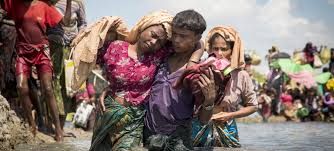The Cries Of Myanmmar
Jun 26, 2019 • 46 views
“They were chased from one country and from another and from another,” “When they arrived at a port or a beach, they gave them a bit of water or a bit to eat and were there chased out to the sea.” “This is a conflict that has not resolved, and this is war, this is called violence, this is called killing!”-Pope Francis
Myanmmar fraught with political, ethnical imbalances make the State a dangerous spot for many of the ethnical minorities residing and originating from it. More than 1,700 people were displaced from villages in Namtu and Hsipaw townships in Shan North due ethnic armed conflict between from only between 27 February and 4 March 2019.
On September 19, 2017 Aung San SUU Kyi finally addressed the issue of violence in Myanmar’s Rakhine state that had been an ongoing occurrence. This period had seed 410000 Rohingya refugees flee to neighbouring countries like Bangladesh with little to no possession.
Her speech was memorable for its misleading information and incorrectness. She chose to ignore reports by the inquiry commission about the sustained violence faced by the Rohingya in an attempt of ethnic cleansing. She denied any claims of discrimination and abuse faced by the Rohigya, claiming “strategy for citizenship requiring co-operation from all communities”.
This was interesting reaction by the person who leads a state that has systematically destroyed their documentation, houses and hope of living a peaceful life in their homeland. She refused to call them ‘Rohingya’ instead used the terms ‘Muslim’ and ‘Bengali’. The speech was not infact for the people of Myanmar rather to be heard around the world by critiques who questioned her silence in this matter.
Till recently Rohingya and Myanmar attracted little to no International attention as most problems were thought to be arising from it’s transition from an authoritarian status to a Democracy, making it a matter of Internal Sovereignty.
The wrong assumption among minds of people generally stems from the idea that Buddhism is a peaceful religion but this ignores existence of extremist Buddhist groups.In Myanmar extremist Buddhist groups have been in the heart of inter-communal violence since its return to relative democracy in 2011.
Rohingyas are largely thought to be outsiders of Bangladeshi origin, therefore treated much worse than any other ethnic minorities. After 1962 the military junta in effect created a new logic whereby only Burman Buddhist could really be loyal citizens. This view spread and further alienated the Rohingyas due to their language, skin and most importantly religion.
The 1974 Constitution of the Socialist Republic of the Union of Burma removed the status of Rohingyas as citizen and described them as foreigners.
Even after democracy and forming constitutions in 1989 and 2008, the legislations repeated the definition of citizenship formed during 1974.
Buddhists monks have become increasingly important in political arena since 1998- the 969 Movement and the MaBaTha. Both are at forefront to demonise the Islam and start various inter-communal violence since 2010. However other monks have been there to disagree with them.
The 2012 massacres can only be described as ethnic cleansing to drive the Rohingyas out of country. The initial random bouts of violence turned to systematic acts to force the Rohingyas out of the state.
The events commenced after the rape and murder of a Rakhine woman by three Muslim, after that a bus of Muslim were stopped and killed. The police (comprised of Rakhine Buddhist) stood to one side at first but then some of them started participating in the violence.

The state refused to help those who suffered or investigate the allegations of security force’s involvement. Instead President Thein Sein called the Rohingyas immigrants and wanted them to be transported to Bangladesh.
The systematic misery of the Rohingyas forced them to seek escape to neighbouring countries in boats. This gained international attention as it became a regular occurrence of the spring. But perhaps the most disturbing aspect of the refugee crises was that there was no obvious immediate trigger in the internal situation in Myanmar. Many of the Rohingyas accepted that there was no place for them in Myanmar. The level of persecution and exclusion has been normalised to the point where Rakhine hospitals refused to treat them if they sustain injury by police or army.
This has caused an influx of slave trade in countries like Thailand. These people or refugees are unable to even receive the basic rights and goods provided to refugees in the refugee camps.
This expresses correctly the distress of the situation of the refugees of the war- a war of ethnicity and religion which plagues the nation of Myanmar. The refugee crises has gained much international attention since but a solution for these people still remains out of reach. Bangladesh famous for sending such refugees back to their countries still remains reluctant to keep these people inside its boundary but agree with the UN report that sending such persons back would be unwise. Though conditions of such refugees are horrible it remains to be said that more of their community remain trapped in the Rakhine after the crises without any healthcare, education or any of the basic human rights.
Thus refugee crises of Myanmar continues with persecution of the Rohingyas, a community that still even at the face of such violence remain quite submissive to horrifying crimes faced by them in the communal internal war inside the boundary of the country.
